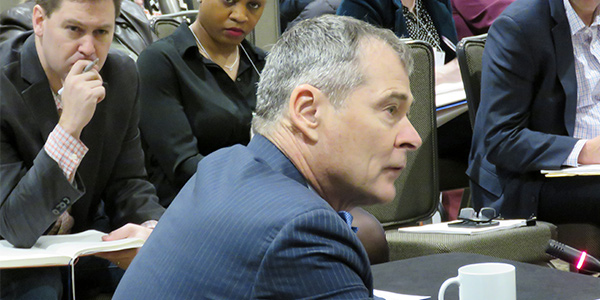By Rich Heidorn Jr.
WASHINGTON — If they build it, will you drive?
Electric vehicle makers are now offering 90 models for sale in the U.S., and the nation’s charging infrastructure grew by 17% last year, according to data released last week by BloombergNEF.
Yet U.S. EV sales dropped 11% in 2019, accounting for just 1.8% of total vehicle sales, Bloomberg reported.
Nevertheless, state regulators said during a panel discussion at the National Association of Regulatory Utility Commissioners’ Winter Policy Summit last week they remain upbeat about the potential for vehicle electrification to help decarbonization efforts — and maybe reduce system costs.
“This is a really exciting time to talk about EVs,” said Al Freeman, an adviser for the Michigan Public Service Commission, who keeps a very busy Google alert to keep track of industry developments.
Michigan’s utilities have made “some really neat [pilot] proposals” to the commission, he said, including $13 million, three-year pilots by both Consumers Energy and DTE Energy, which were approved by the commission last year.
“There’s a lot of challenges, but they’re responding to it very well and being aggressive in the marketing and the education of it,” he said of Consumers. DTE has been similarly aggressive, he said. “A lot of their costs have come in below what they estimated, which will allow them to have a little bit more money for additional rebates.”
2 Questions
Hanna Terwilliger, economic analyst for the Minnesota Public Utilities Commission, said EV growth is outpacing rooftop solar in her state, although enrolling owners in time-of-use rates remains a key challenge.
Terwilliger said Minnesota is seeking to integrate EVs in a way that benefits all customers and avoids adverse system impacts. It’s also considering whether it should encourage widespread adoption of EVs to meet policy goals, such as carbon reductions.
“Each state will have different answers to these questions, but we all need to … make sure we’re prepared because … even just one EV charging at a house can double their electric consumption, and they’re coming faster than other types of [distributed energy resources] like rooftop solar,” she said.
Americans have purchased or leased 1.4 million battery-electric and plug-in hybrid electric vehicles since 2010, according to BloombergNEF. Minnesota has about 10,000 EVs, most in its metro areas but with some penetration in rural areas as well.
But while the Dakota Electric Association has almost half of their EVs enrolled in TOU or off-peak rates, Minnesota Power, Otter Tail Power and Xcel Energy have struggled to get participation above 10%. Terwilliger said a big challenge is the expense of installing a second TOU meter.
Asked to explain the disparity, Terwilliger noted that Dakota is an electric cooperative. “Anecdotally, from other co-ops that have similar rates, they’re also around 50%,” she said.
“There’s a number of reasons why co-ops have been more successful. They historically have had a lot more demand-response programs, and they’ve been able to expand those programs to include EVs. So, a lot of the infrastructure is already there. It’s less expensive to enroll customers in the rate. I think that co-ops also have a lot more direct communication with their members. Members want to read the newsletters that come out, versus if you’re trying to [communicate] something on a bill insert, there’s a lot of times people just throw it away.” Some customers get electronic bills and don’t receive bill inserts, she added.
She said utilities must enroll EV drivers in some type of managed charging rate when they purchase their cars. “Even if it’s not perfect, it’s much easier to switch a customer to more sophisticated program than it is to try and go and find them” after the sale.
It’s also important to have the rate structure ready to accommodate and encourage fleets switching to EVs, she said, noting Amazon’s plan to purchase 100,000 EV delivery vans, reportedly the largest EV order ever. “When they start coming into your service territory, Amazon does not want to wait for you to go through a regulatory process. They want a good solution there right now that’s going to save them money.”
Red State Message

Tim Echols, vice chair of the Georgia Public Service Commission, lamented that his state in 2015 abolished the $5,000 tax credit that had made it one of the early leaders in EV growth. He said the credit died because messaging about EVs’ environmental benefits took “all the oxygen in the … room.”
“I’m on my fourth EV. I’m a big proponent. But we’re making a switch [in messaging]. We have five Republican commissioners. Every constitutional officer in Georgia is a Republican. And we’re beginning to talk about how EVs charged at home overnight put downward pressure on rates. That’s the new red state message. Nothing else about the environment, because our left-leaning friends are going to come with us no matter what. … It’s the Republicans that are holding us up on this.”







